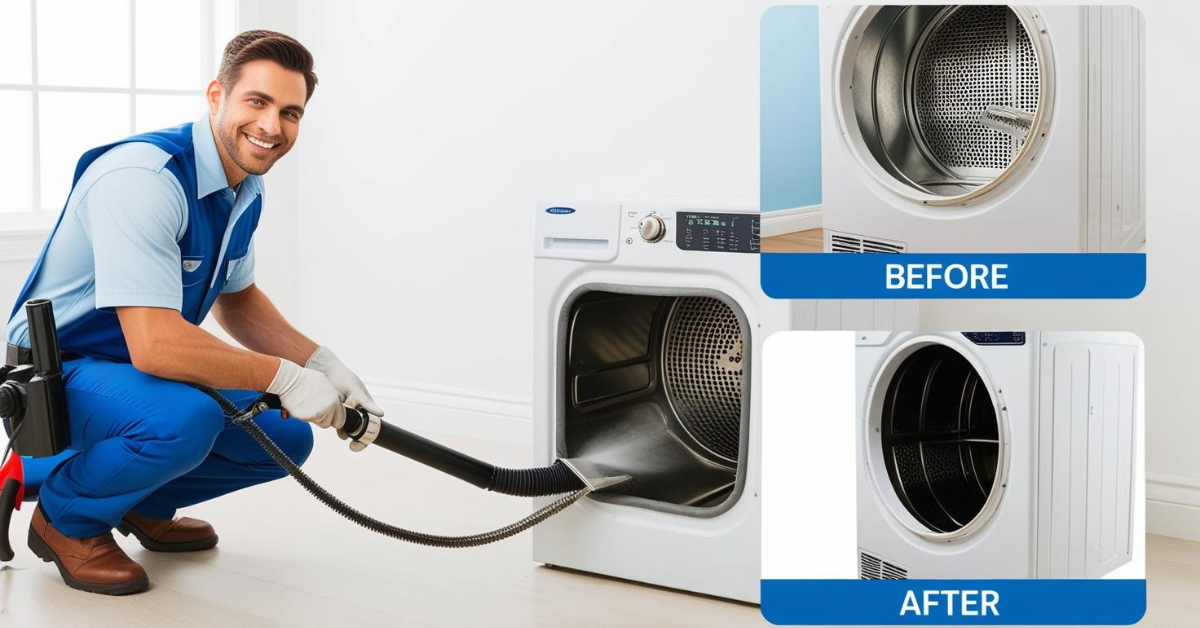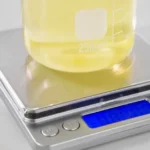Have you ever thought about what’s happening inside your dryer vent? Most of us rely on our dryers to keep clothes warm and dry, but we don’t often think about how the vent works—or what happens if it gets clogged. Over time, lint, dust, and even small animals can block the vent, making the dryer work harder. This not only raises your energy bills but can also create serious risks, like fires. Thousands of house fires are caused each year by clogged dryer vents. So, isn’t it worth taking a little time to keep your dryer running safely and smoothly?
A clogged vent doesn’t just create safety problems—it can cost you money and cause wear and tear on your dryer and clothes. When the vent is blocked, the dryer takes longer to work, which uses more energy and makes your bills go up. Plus, all that extra heat can damage your clothes, causing them to shrink or fade faster. Cleaning your dryer vent regularly is a simple way to keep your home safe, protect your clothes, and save money. This guide will show you easy steps to keep your dryer in great shape.
Why is Keeping the Vent System Clean So Important?
Think of the vent as the dryer’s lungs. When airflow is restricted, the dryer struggles to breathe, and that can lead to all sorts of problems. Let’s break it down further:
- Fire Safety: Lint may seem harmless, but it’s highly flammable. The U.S. Fire Administration reports thousands of dryer fires each year, with clogged vents being a leading cause. Imagine a tiny spark igniting a buildup of lint—the consequences could be devastating.
- Energy Efficiency: A clogged vent forces the dryer to work harder, consuming more energy. The result? Skyrocketing energy bills. Think of it like trying to sip a thick milkshake through a narrow straw—it takes a lot more effort than it should.
- Clothing Longevity: Excess heat from poor ventilation doesn’t just overwork the dryer; it overworks the fabrics too. Over time, this can cause clothes to shrink, fade, or wear out faster.
- Appliance Lifespan: Strain on the dryer can lead to frequent breakdowns and costly repairs. Maintaining a clean vent extends the life of the appliance, saving money in the long run.
- Health Concerns: A poorly ventilated dryer can lead to excess moisture, creating an ideal environment for mold and mildew. For those with allergies or asthma, this can worsen respiratory issues and impact overall indoor air quality.
How to Recognize When Cleaning Is Needed
Not sure if the vent needs attention? Pay attention to these warning signs:
- Longer Drying Times: When clothes take more than one cycle to dry, it’s a clear sign of restricted airflow. This not only wastes time but also increases energy usage.
- Burning Smell: A burning odor while the dryer is running could indicate lint buildup near the heating element. Don’t ignore this; it’s a red flag.
- Excess Lint: Lint should stay confined to the lint trap. If it’s spilling out around the dryer or on the floor, it’s time to take action.
- Overheating: If the dryer feels excessively hot to the touch or shuts off unexpectedly during a cycle, poor ventilation might be to blame.
- Reduced Efficiency: Higher energy bills despite regular usage often point to a clogged vent. Think of it as your dryer waving a white flag, asking for help.
- No Visible Exhaust: When the dryer is running, check the exterior vent. If there’s weak or no airflow, the vent is likely obstructed.
Ignoring these signs can lead to bigger problems—and bigger expenses—down the road.
Step-by-Step Guide to Clearing the Vent System
Cleaning the vent might sound intimidating, but with the right tools and a little patience, it’s a manageable task. Here’s how to do it:
Gather the Necessary Tools
Make sure to have the following items ready:
- Vacuum cleaner with a hose attachment
- Vent cleaning brush kit (includes long brushes and flexible rods)
- Screwdriver (to detach and reattach parts)
- Flashlight (to inspect hard-to-see areas)
- Duct tape (optional for resealing)
Unplug the Dryer
Safety first! Disconnect the dryer from its power source. If it’s a gas dryer, turn off the gas supply to prevent leaks.
Locate the Vent
Identify both ends of the vent system: the connection behind the dryer and the exterior vent outside the home. Knowing where the airflow begins and ends is key.
Disconnect the Vent Hose
Use a screwdriver to detach the vent hose from the back of the dryer. Be gentle to avoid damaging the hose or its connectors.
Remove Lint from the Hose
Insert a vent cleaning brush into the hose, rotating it to dislodge lint buildup. Slowly pull the brush out, clearing debris as you go. Use a vacuum to suck up loosened lint for thorough cleaning.
Inspect and Clean the Exterior Vent
Go outside and remove the vent cover. Check for obstructions like lint, leaves, or even bird nests. Use the brush to clean the vent thoroughly, ensuring strong airflow.
Reattach the Vent Hose
Once cleaned, reconnect the hose to the dryer and secure it with clamps or screws. Ensure the connection is tight to prevent future leaks.
Test the System
Run the dryer on a short cycle and check the airflow at the exterior vent. Strong exhaust indicates a job well done.
Professional vs. DIY Maintenance
While cleaning the vent is often a straightforward task, there are situations where professional help might be necessary. Here’s how to decide:
When to DIY
- The vent system is short and easy to access.
- Tools and time are readily available.
- There’s confidence in handling basic maintenance tasks.
When to Call a Professional
- The vent system is long, complex, or difficult to reach.
- There are signs of mold, pests, or severe blockages.
- Persistent issues remain even after DIY cleaning efforts.
Professional cleaners have specialized tools and expertise to handle even the toughest clogs, ensuring the system is safe and efficient.
How Often Should Vent Maintenance Be Done?
Routine maintenance keeps the dryer running smoothly and safely. Most households benefit from cleaning the vent annually, but some situations call for more frequent attention:
- Heavy Usage: Homes with large families or daily dryer use should consider cleaning the vent every six months.
- Homes with Pets: Pet hair can mix with lint, accelerating buildup. More frequent cleaning helps keep the system clear.
- Older Appliances: Older dryers may not trap lint as effectively, requiring extra vigilance.
Preventive Tips to Minimize Lint Buildup
Prevention is often easier than dealing with a full-blown clog. Adopt these simple practices:
- Empty the Lint Trap Regularly: Clean the lint trap after every drying cycle. This small step can significantly reduce buildup in the vent.
- Avoid Overloading: Filling the dryer might seem efficient, but it restricts airflow and generates excess lint. Stick to moderate loads.
- Upgrade Vent Materials: Opt for rigid or semi-rigid metal ducts instead of flexible plastic ones. Metal ducts are less prone to lint accumulation and are safer in the event of overheating.
- Inspect the Exterior Vent: Check the outside vent cover periodically to ensure it’s free from debris, bird nests, or other obstructions.
- Invest in Professional Cleaning: Even with regular DIY maintenance, scheduling a professional inspection every couple of years can catch issues before they become major problems.
Potential Risks of Ignoring Vent Maintenance
Neglecting this task can lead to serious consequences.
- Fire Hazards: Lint’s flammability makes a clogged vent a fire risk. All it takes is a small spark to ignite a dangerous situation.
- Increased Energy Bills: A blocked vent forces the dryer to use more energy, driving up costs. Over time, this adds up significantly.
- Costly Repairs: Excess strain on the dryer can lead to frequent breakdowns. Repairing or replacing parts is far more expensive than routine cleaning.
- Mold and Mildew Growth: Trapped moisture in a clogged vent creates an ideal breeding ground for mold. This can lead to structural damage and health concerns.
- Health Concerns: Poor ventilation can circulate allergens and irritants, reducing indoor air quality and impacting respiratory health.
Environmental Benefits of Regular Vent Maintenance
Keeping the vent system clean doesn’t just save money and improve safety—it also benefits the environment:
- Energy Conservation: Efficient dryers use less electricity, reducing the household’s carbon footprint.
- Reduced Waste: Extending the life of the appliance means fewer dryers end up in landfills.
- Sustainable Living: Taking care of appliances promotes a more sustainable lifestyle, benefiting both the household and the planet.
Wrapping Up
Maintaining a clean vent system is an essential yet often overlooked part of home care. Beyond saving money and energy, it ensures safety, improves indoor air quality, and prolongs the life of the dryer. By addressing clogs promptly and adopting preventive measures, homeowners can enjoy peace of mind and a more efficient laundry routine. Don’t let this simple maintenance task slip through the cracks—a little effort goes a long way.
FAQs:
How often should vent systems be cleaned?
Annual cleaning is recommended for most households. However, homes with heavy dryer use or pets may benefit from biannual maintenance.
What are the signs of a clogged vent?
Signs include longer drying times, a burning smell, excessive lint, overheating, and weak airflow from the exterior vent.
Can clogged vents cause health issues?
Yes, poor ventilation can lead to mold growth and reduced air quality, which may worsen allergies and respiratory problems.
Is professional cleaning expensive?
The cost varies but is often worth it for safety and efficiency, especially for complex vent systems.
Are plastic ducts safe for dryer ventilation?
Plastic ducts are not ideal as they trap lint more easily and are a greater fire hazard. Opt for rigid or semi-rigid metal ducts for better safety and efficiency.











